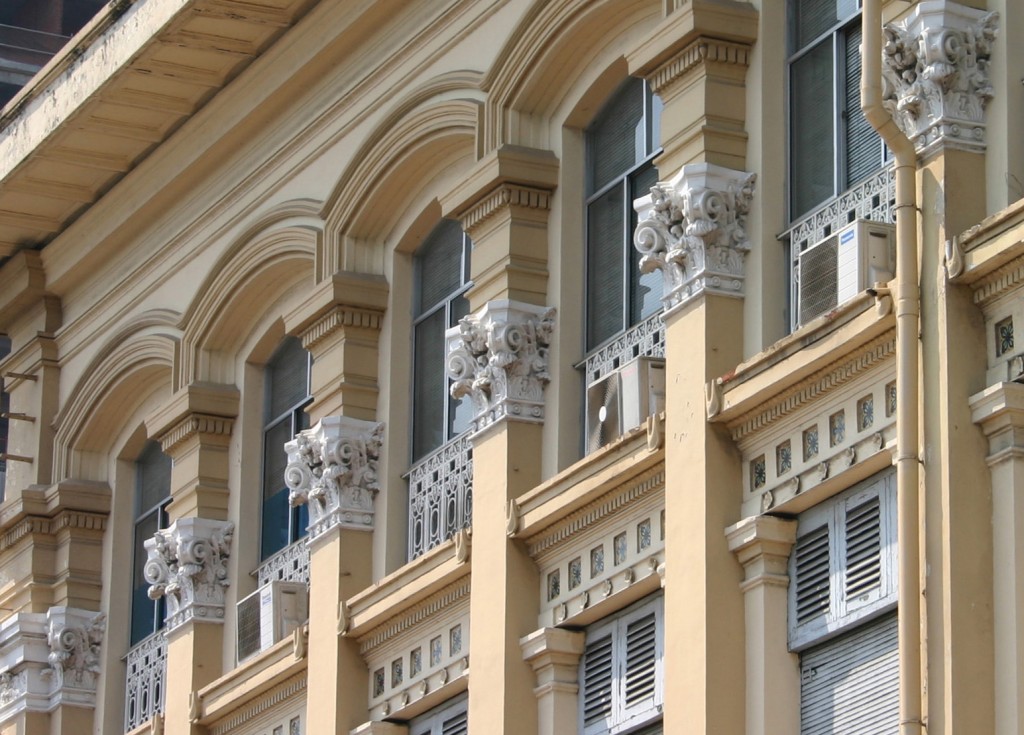
The windows of Foulhoux’s Customs House building, decorated with opium poppies
It has been said that few colonial officials made their mark on the urban fabric of Saïgon as distinctively as Cochinchina’s first chief architect, Marie-Alfred Foulhoux (1840-1892).
Born in Mauzun (Puy-de-Dôme) on 23 September 1840, Foulhoux studied architecture at the École des Beaux-Arts in Paris from 1862 to 1870 and subsequently became an Architect-Inspector with the Compagnie des Chemins de fer de Paris à Lyon et à la Méditerranée (PLM), one of the most important private railway companies in France.
In 1874 he left for Saïgon, where in the following year he succeeded Paulin Vial as Director of Civic Buildings. Then in 1879, following the establishment of the first civil regime in Cochinchina under Governor Charles Le Myre de Vilers, Foulhoux was appointed Architect-in-Chief, permitting him to focus exclusively on what he did best – designing civic buildings for the colony.

The Palais de Justice (1885)
It was while serving as Director of Civic Buildings that Foulhoux designed his first major work, the Secrétariat général du gouvernement, now the Department of Information and Communications and Department of Trade and Industry offices at 59-61 Lý Tự Trọng, constructed in 1875-1881.
This was followed by the Palais de Justice, now the People’s Law Court at 131 Nam Kỳ Khởi Nghĩa. Built in 1881-1885 to replace and earlier building on a different site, this two-storey neo-classical edifice incorporated exterior verandas to enhance ventilation and featured decorative work and statuary by Notre Dame Cathedral architect Jules Bourard. In 1961, a rear extension was built to a clever design by Xá Lợi Pagoda architect Đỗ Bá Vinh which harmonised perfectly with the original.
Sadly, Foulhoux’s third major work in Saïgon, the headquarters of the Direction du Service local which once stood on the site of today’s Sheraton Saigon Hotel, was demolished in the 1950s. However, three other important Foulhoux works have survived for posterity.
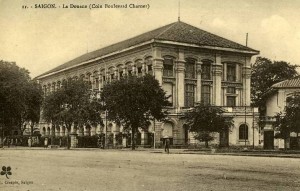
The Hôtel des douanes (1887)
After the colonial authorities ended Cantonese trader Wang Tai’s monopoly on the supply and refining of opium in 1881 (see Wang Tai and the Cochinchina opium monopoly), the Customs and Excise Department purchased his former Saigon headquarters building on the Saïgon riverfront – the “Maison Wang Tai” – to use as their main office. However, it proved insufficient for their needs, so in 1885-1887 it was rebuilt to a design by Foulhoux as the Hôtel des douanes or Customs Department building. Writer, journalist and Indochina specialist Jules Boissière (1863-1897) pointed out that the badges separating its windows featured opium poppies, then one of the most important sources of revenue for the colonial government. In fact, the same floral motifs may be seen on several other former French government buildings in the city.
Arguably, Foulhoux’s best-known work is the Lieutenant Governor’s Palace, completed in 1890 and currently home to the Hồ Chí Minh City Museum. Having initially been instructed to design an exhibition hall for the display of trade products, Foulhoux was obliged to repurpose the building half way through construction, when it was announced in October 1887 that Hà Nội would be the new seat of the Governors General of Indochina. No longer deemed senior enough to occupy the stately 1873 Norodom Palace (see Saigon’s Palais Norodom – A Palace Without Purpose), the newly-downgraded Lieutenant Governors of Cochinchina were hastily found humbler accommodation in the exhibition hall, which was refurbished at considerable cost to serve as their official residence.
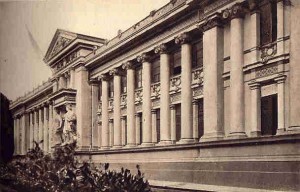
The Lieutenant Governor’s Palace (1890)
From 1890-1911 the Lieutenant Governor’s Palace was home to 13 Lieutenant Governors and from 1911-1945 to another 16 Governors of Cochinchina. It later variously accommodated the Japanese governor, the special envoy of former King Bảo Đại, the Việt Minh and the Head of the British Military Mission charged with overseeing the return of the French colonial authorities after World War II. Its last famous resident was South Vietnamese President Ngô Đình Diệm, who relocated here in February 1962 while his new Independence Palace was under construction and had a network of secret tunnels built beneath its floor so that he could take shelter and if necessary escape in the event of a further coup attempt. When a coup did take place in early November 1963, Diệm used that tunnel network to escape onto Lê Thánh Tôn street and flee to Chợ Lớn, but on the following day he and his brother were captured and assassinated.
Foulhoux’s final work, the Hôtel des postes or Central Post Office, is widely regarded as his greatest, though unfortunately many local tour guides quote the Wikipedia article which erroneously credits the building to Gustave Eiffel. Built between 1886 and 1891 on the site of the former headquarters of the Commandant des troupes, it was constructed around a prefabricated cast iron frame, permitting the creation of a unique vaulted ceiling with wrought iron beams and columns reminiscent of industrial architecture.
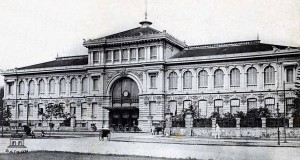
The Hôtel des postes (1891)
It was later reported that Foulhoux’s intention was to capture the essence of human scientific and technical advancement, a theme which is continued on the Neo-Baroque façade with its window plaques bearing the names of leading scientists and philosophers like Descartes, Morse, Ampere, Volta, Ohm and Faraday.
A statue of the Greek messenger goddess Iris once stood in the centre of the main lobby, but this was removed in the 1950s to create more space.
On 15 September 1891, the journal Architecte constructeur: Revue du monde architectural et artistique of 15 September 1891 commented: “The inauguration the new Saigon Post Office, which was held on July 14, had been postponed until the return of the Governor General. This monument, adorned with a most artistic façade, is particularly well laid out and well equipped for the different services to which it is intended; it does the greatest honour to the skill and talent of the distinguished Chief Architect of the Colony, M. Foulhoux.”
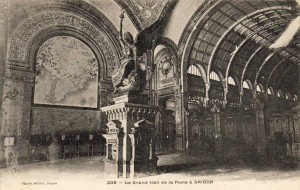
A statue of the Greek messenger goddess Iris once stood in the main lobby of the Hôtel de postes
While his contribution to city planning in Saigon received little coverage back home in France, Foulhoux was briefly fêted in Paris in 1889 for the beautiful red teak Palais Annamite which he created on the esplanade des Invalides for the Universal Exposition of that year.
In November 1890, Foulhoux stood unsuccessfully for the elected post of Mayor of Saigon, losing to Eugène Cuniac. In the following month he was made an Officier de la Légion d’honneur and Officier d’Académie.
Marie-Alfred Foulhoux died in Saïgon after a brief illness on 20 January 1892, aged just 52. He was buried in the Cimetière de la rue Massiges, Saigon’s main European cemetery during the colonial era. The entire cemetery was cleared in 1983 to make way for the Lê Văn Tám Park – see Le Van Tam Park – Former Massiges Cemetery, 1859.
Foulhoux’s obituary, also published in the journal L’Architecte constructeur, described him as “a benevolent official with a gentle and conciliatory character, esteemed by all who knew him” ….adding that he was a passionate hunter.
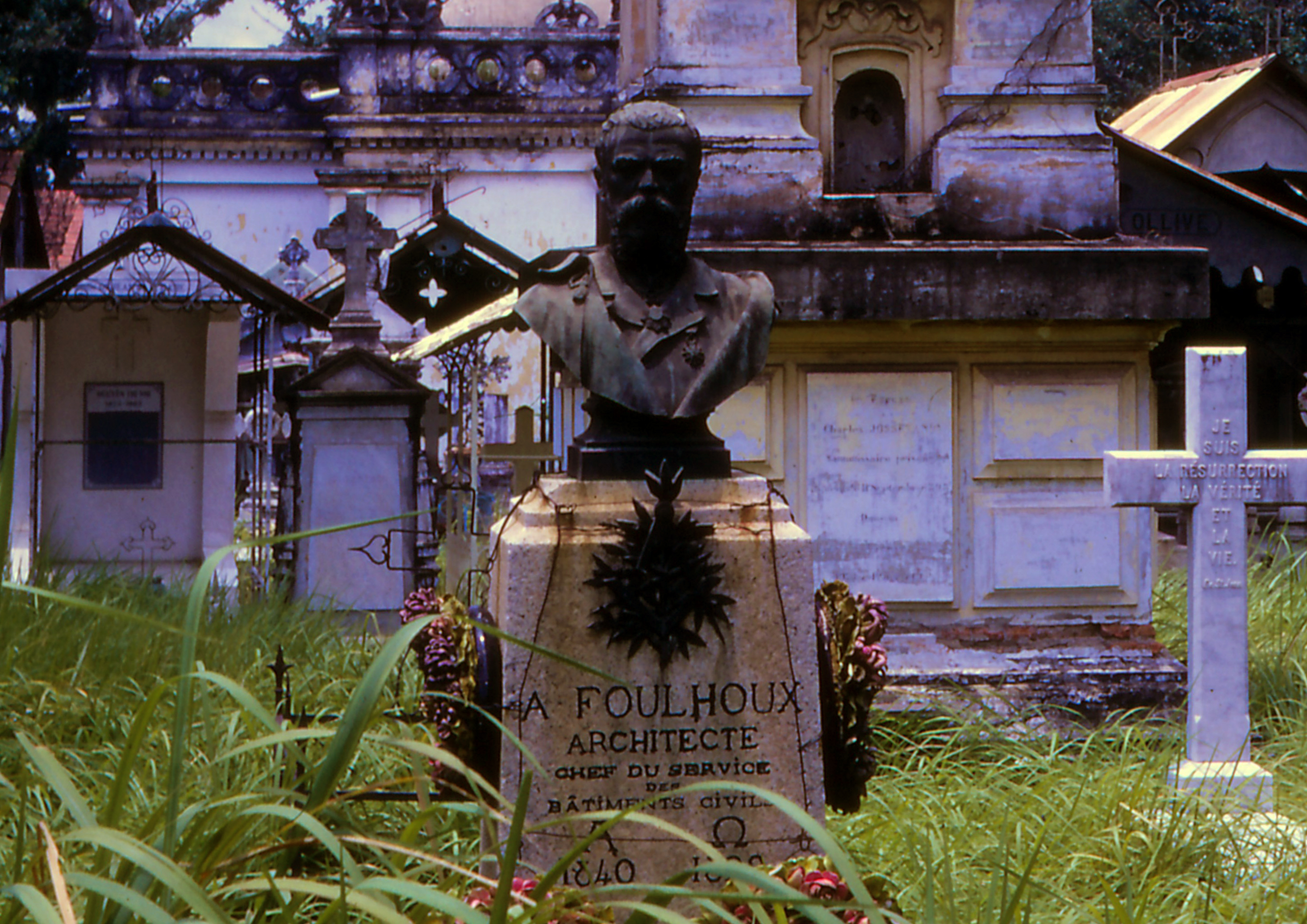
Alfred Foulhoux was buried in the Cimetière de la rue Massiges in Saigon. I am grateful to Frederick P. Fellers of Indianapolis, USA for making available this photograph of Foulhoux’s tombstone, which he took in 1970.
Tim Doling is the author of the guidebook Exploring Saigon-Chợ Lớn – Vanishing heritage of Hồ Chí Minh City (Nhà Xuất Bản Thế Giới, Hà Nội, 2019)
A full index of all Tim’s blog articles since November 2013 is now available here.
Join the Facebook group pages Saigon-Chợ Lớn Then & Now to see historic photographs juxtaposed with new ones taken in the same locations, and Đài Quan sát Di sản Sài Gòn – Saigon Heritage Observatory for up-to-date information on conservation issues in Saigon and Chợ Lớn.

